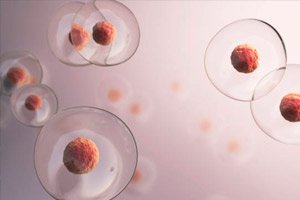
All iLive content is medically reviewed or fact checked to ensure as much factual accuracy as possible.
We have strict sourcing guidelines and only link to reputable media sites, academic research institutions and, whenever possible, medically peer reviewed studies. Note that the numbers in parentheses ([1], [2], etc.) are clickable links to these studies.
If you feel that any of our content is inaccurate, out-of-date, or otherwise questionable, please select it and press Ctrl + Enter.
How to Turn a Drop of Blood into a Universal Cell: Stem Cell Revolutionary Chemicals
Last reviewed: 09.08.2025
 ">
">Until recently, turning an adult cell into a pluripotent cell (able to become any type of tissue) required introducing “Yamanaka factors” into it using viruses or DNA plasmids. Now, researchers from the US, Japan and France, led by Dr. Feng Peng, have demonstrated that just a set of small organic molecules is enough to reprogram human peripheral blood cells into chemically induced pluripotent stem (hCiPS) cells. The study is published in the journal Cell Stem Cell.
Why is this important?
- Safety. The absence of viral vectors and foreign genes reduces the risk of mutations and immune rejection.
- Versatility: Blood is an accessible source: no need to take skin or other tissue biopsies.
- Speed. Only 12-14 days instead of several weeks or months, as with the classical method.
- Translatability. Chemicals are easy to standardize and produce according to GMP standards.
Two-Step Chemical Hacking Protocol
High plasticity stage (Plastic State).
Blood cells (mononuclear cells) are cultured in a medium with six small molecules (let's call them the TNT complex). Among them:
GSK3β and MEK inhibitors,
Wnt signaling modulators,
HDAC inhibitors,
Specific SIRT1 agonists.
In 6–8 days, the cells lose their “blood” markers and acquire the properties of highly plastic epithelium, ready to activate pluripotent genes.
The stage of consolidation of pluripotency.
Two additional molecules are added that stimulate the endogenous activation of the OCT4, SOX2 and NANOG genes, the key “master regulators” of pluripotency.
Over the next 4–6 days, stable colonies of hCiPS cells with stem cell morphology and expression of TRA-1-60 and SSEA-4 markers are formed.
What did the scientists get?
- Efficiency: up to 0.1% of the original blood cells form full-fledged hCiPS colonies - comparable to traditional viral methods.
- Functionality: hCiPS cells are capable of transforming into all three embryonic germ layers: neurons, cardiomyocytes, liver cells, pancreatic β-cells, etc.
- No residual 'chemical fingerprints': deep sequencing revealed no integration of exogenous DNA and an epigenetic state close to embryonic stem cells.
Prospects for Medicine
- Hematopoietic regeneration. Autologous hCiPS cells can be redirected back into the hematopoietic lineage, restoring dozens of immune and blood cell types in leukemias and immunodeficiencies.
- Organoids and transplantation. Lab-grown mini-hearts, livers or pancreases from hCiPS cells will serve as a model of diseases and a source for transplantation without the risk of rejection.
- Drug testing. Personalized disease models based on hCiPS will allow to “replicate” the disease from streak blood and select the optimal therapy.
- Cosmetic and neurodegenerative medicine. Directed differentiation of hCiPS cells into dermal stem and neuronal systems offers new approaches to the treatment of psoriasis, Alzheimer's and Parkinson's.
What's next?
- Improving efficiency. Optimizing the composition of small molecules and culture conditions, increasing the yield of hCiPS colonies.
- Safety and long-term follow-up. Testing for genomic stability and absence of malignant transformation in vivo.
- Clinical trials. Phase I/II with assessment of safety and bioavailability of hCiPS products in the treatment of severe blood diseases and cardiomyopathies.
“The complete chemical reboot of the blood cell stem code is a real breakthrough, opening the door to accessible and safe cellular medicine without viral interventions,” concludes Dr. Feng Peng.
The authors note several key points:
Genome-Free Safety
“The absence of integration of exogenous genes into the hCiPS cell genome reduces the risk of oncogenic transformation and immune rejection compared to viral methods,” emphasizes Dr. Feng Peng, senior author of the study.Standardizability of the protocol
“The chemical approach facilitates scaling and standardization of stem cell production under GMP conditions – it is enough to prepare a solution of six small molecules and follow strict timing,” adds co-author Prof. Maria Lebedeva.Clinical Outlook
“We plan to evaluate hCiPS cells in leukemia and diabetes models to see how quickly they reconstitute hematopoiesis and β cells without the risks associated with viral vectors,” says Dr. Jonathan Smith.Long-term stability
“Preliminary data show that hCiPS retain genomic and epigenetic stability after 20–30 passages, which is important for subsequent therapeutic applications,” notes Dr. Aiko Yamamoto.
These comments highlight that chemical repurposing of blood cells into pluripotent stem cells combines safety, standardizability and clinical potential for personalized regenerative medicine.
